Are you an entrepreneur who wants to know “how much does software development cost?”
Drawing from over a decade of experience as a top-rated web development agency with a global clientele, we've observed that the average web development project typically takes 1 to 6 months, with costs ranging between $5,000 and $30,000. However, these figures can vary significantly based on a multitude of factors. To learn more about what influences these costs, continue reading.
At Greenice, we deeply understand the nuances of software development costs and are dedicated to delivering solutions tailored to meet your business needs. Since our inception in 2007, we have successfully completed over 200 projects, collaborating with clients across the globe.
How much does software development cost?
Well, it depends. Significantly. But let’s try to give at least a ballpark estimate.
Average software development project cost
As previously mentioned, the development of a project typically spans 1 to 6 months with costs ranging from $5,000 to $30,000. This estimate applies to the custom development of various web applications, including marketplaces, CRM systems, and SaaS solutions.
However, the cost of software development is influenced by multiple factors, including project complexity, chosen technology, scope, and the specific industry involved. Due to these variables, the project cost range can fluctuate from $3,000 to $150,000, while the price for the most expensive software can surpass $1,000,000.
Software development life cycle and cost for every stage
Now, let's explore how costs are distributed across each stage of a project to ensure effective budget management and strategic project planning. Below is a detailed breakdown of the expenses associated with each phase:

Planning
The planning phase is foundational, setting the trajectory for the entire project. In this stage, project goals are defined and a comprehensive roadmap is laid out. Allocating about 10-15% of the total budget to planning is typical, reflecting its critical role in aligning the project’s scope with business objectives and laying a clear path forward.
Defining requirements
Capturing detailed and precise requirements is crucial to the project's success, consuming about 10-20% of the total budget. This stage ensures that all project stakeholders have a common understanding of the project objectives and deliverables, which helps in avoiding scope creep—uncontrolled changes or continuous growth in a project’s scope.
Designing
In the design phase, both user experience (UX) and user interface (UI) are crafted, accounting for 15-25% of the budget. This stage transforms the project requirements into a blueprint for the software application, focusing on user interaction, aesthetic appeal, and overall functionality. Effective design can significantly influence the end-user acceptance and usability of the software.
Developing
Development is the most resource-intensive phase, where actual coding and implementation of the software occur, consuming 30-50% of the budget. This stage involves translating design documentation into actual software within the development environment. It's where developers spend most of their time coding the application's functionality.
Testing
Testing is essential for verifying and validating the software to ensure it meets all specifications and is free of defects. This phase generally requires 10-20% of the budget. Effective testing improves the quality of the software product, reduces maintenance costs, and ensures a smoother deployment.
Deploying
Deployment involves the release of the software to the production environment, which typically uses up 5-10% of the total budget. This stage may include setting up the server environment, configuring the software to operate within a specific framework, and ensuring that everything functions as expected in a live setting.
Maintaining
After deployment, ongoing maintenance is crucial for ensuring the software continues to function correctly as it interacts with real-world data and users. Maintenance can cost an additional 15-20% annually of the initial development cost. This includes fixing bugs, updating software to comply with new regulations or hardware updates, and adding new features as required.
Examples of project costs by software type
Given that costs can vary significantly between companies and projects, providing an exact estimate is challenging. However, we can offer you estimates based on our extensive experience with specific types of web development projects, including marketplaces, CRM and ERP systems, SaaS products, chatbots, and cross-platform mobile apps.
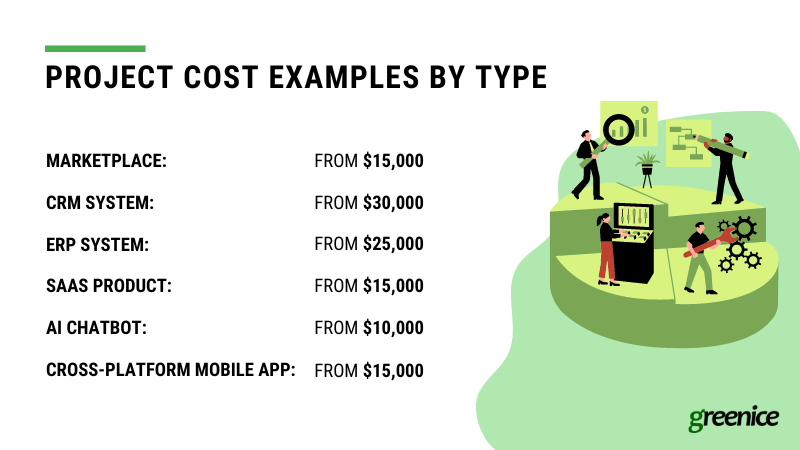
Marketplace:
A marketplace is a digital platform where multiple vendors can sell their products or services to a variety of buyers, for example, Amazon, eBay, and Airbnb. This is more complex than a typical online store that represents a single vendor. Each seller on these platforms can manage their own profile, showcasing their offerings.
Essential features of a marketplace include user registration for both sellers and buyers, profile management, robust search functionality, secure payment processing, and systems for reviews and ratings. Additionally, analytics and reporting tools are important for providing insights into sales and customer behavior.
For a custom-developed marketplace that incorporates specific requirements and unique features, costs start at approximately $15,000 and can increase based on the project's complexity and the advanced functionalities needed.
The starting cost for developing a marketplace using a white-label solution is $5,000, with potential increases depending on the complexity of the themes, plugins, and integrations required. Later in the article, we'll detail how to effectively utilize white-label solutions to maximize cost savings.
CRM system:
A Customer Relationship Management (CRM) system is a vital tool designed to help businesses manage their interactions with current and potential customers. By integrating various data streams—sales, marketing, and customer service—CRM systems provide a unified view that helps enhance customer satisfaction and retention. These can range from simple solutions that manage customer contacts and interactions to more advanced systems that integrate sales tracking, productivity tools, and automation of marketing campaigns.
Developing a custom CRM system tailored to specific business processes starts from $30,000.
ERP system:
Enterprise Resource Planning (ERP) systems are comprehensive platforms that integrate all facets of an enterprise's operations, including product planning, development, manufacturing processes, sales, and marketing. These systems streamline processes across the organization by consolidating all the information into one cohesive system.
An MVP for an ERP system can cost between $25,000 to $50,000, while more complex solutions can exceed $100,000 depending on the functionality and integration depth required.
SaaS product:
Software as a Service (SaaS) products are applications hosted by a third-party provider and made available to customers over the internet. These products are diverse, ranging from applications for business management, such as accounting and project management, to customer relationship management. Think about the most popular software like Slack, Adobe, or Zoom. SaaS products eliminate the need for organizations to install and run applications on their individual computer systems and servers, facilitating maintenance and support.
Typically, SaaS products offer customizable user interfaces, integration with other software, automatic updates, scalability options, and data security measures.
Depending on functionality, SaaS development costs can start from $15,000.
AI chatbot:
AI chatbots are artificial intelligence systems designed to conduct conversations via auditory or textual methods. They are used extensively in customer service to handle inquiries without human intervention, and can also be employed in various interactive tasks such as collecting information from users, helping to navigate websites, or as part of a customer engagement strategy.
AI chatbots can range from simple query-based versions that provide users with predefined answers to more sophisticated systems that use natural language processing and machine learning to provide more dynamic responses.
Development for AI chatbots starts at about $10,000 for basic bots, and costs can increase substantially with the complexity of the tasks the bot is required to perform.
Cross-platform mobile app:
Cross-platform mobile apps operate seamlessly across multiple mobile platforms and devices, significantly reducing development time and costs by utilizing a single codebase for both iOS and Android. This approach ensures consistent user experience and functionality across platforms while simplifying maintenance and updates.
These apps can support a broad range of features thanks to technologies like React Native, Flutter, and Node.js. They provide a close-to-native user experience, offer visually attractive and responsive interfaces, and have high performance and scalability.
The cost of developing cross-platform mobile apps starts around $15,000.
Key factors affecting software development cost
The main things affecting development costs are how long developers work on the project (time) and how much they charge for their work (hourly rate). Let’s explore this in detail.
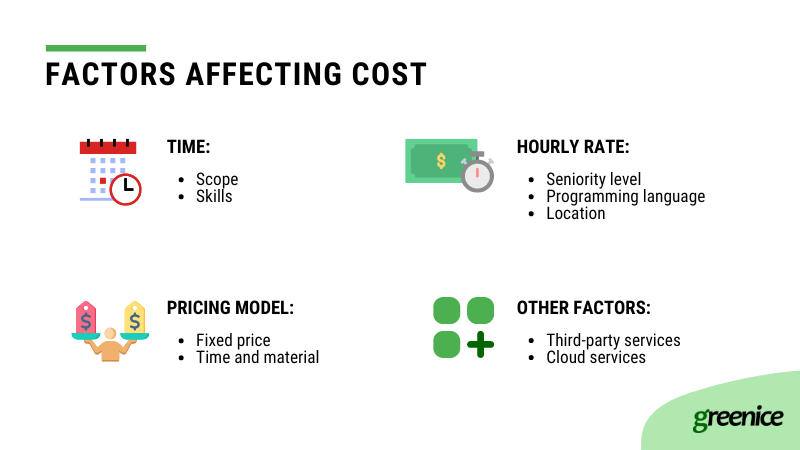
Time
- Scope: The scope of the project, encompassing both functional and non-functional requirements, is a primary cost driver. Functional requirements dictate what the software will do, involving specific tasks and functionalities. Non-functional requirements cover the software's performance, usability, reliability, and security. Advanced features and multiple non-functional requirements lead to the price increase. So the more complex design you want (e.g. ML price comparison mechanism) the more you will pay for it.
Imagine a giant website similar to Zillow, which has a broad range of features for sellers, and real estate agents. Such a project would involve integrations with various Multiple Listing Services, AI capabilities for property valuation, and a CRM system for agents. The development of these complex systems requires substantial time and human resources and spans several years. - Skill and experience: One developer might complete a project in a month, another might need two months, and a third may never finish it. The key differences among them are skills and experience. Skilled developers with relevant experience can execute tasks more efficiently, significantly impacting the overall development time and cost. Their ability to navigate complex challenges quickly and effectively can streamline the development process, leading to cost savings and expedited project timelines.
Hourly rate
- Seniority level: The cost of hiring software developers often varies greatly depending on their level of experience, or seniority. Typically, more experienced developers command higher rates. However, this investment can lead to significant long-term savings through reduced development time, fewer errors, and diminished need for extensive revisions. Let’s compare hourly rates based on seniority, using as an example PHP developers on Upwork:
- Junior: $15 per hour
- Middle: $30 per hour
- Senior / Full-stack: $45 per hour
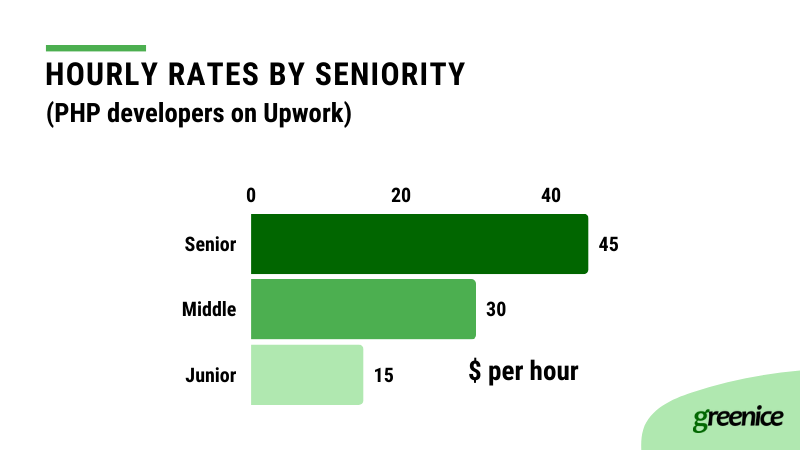
- Programming language: The cost of development can also be influenced by the programming language used, as the availability and specialization of developers for each language vary. Languages that are easier to learn often have a larger pool of developers, which can drive down costs. Conversely, languages like Scala or Zig, which have fewer specialized developers, may command higher rates due to increased demand for these rarer skills. This disparity affects overall project costs, as the scarcity of expertise in certain languages can lead to premium pricing. Based on developers’ salaries from the Stack Overflow Survey in 2023, here are hourly rates for some languages:
- Zig: $52 per hour
- Ruby: $49 per hour
- Python: $39 per hour
- JavaScript: $37 per hour
- HTML/CSS: $35 per hour
- PHP: $29 per hour
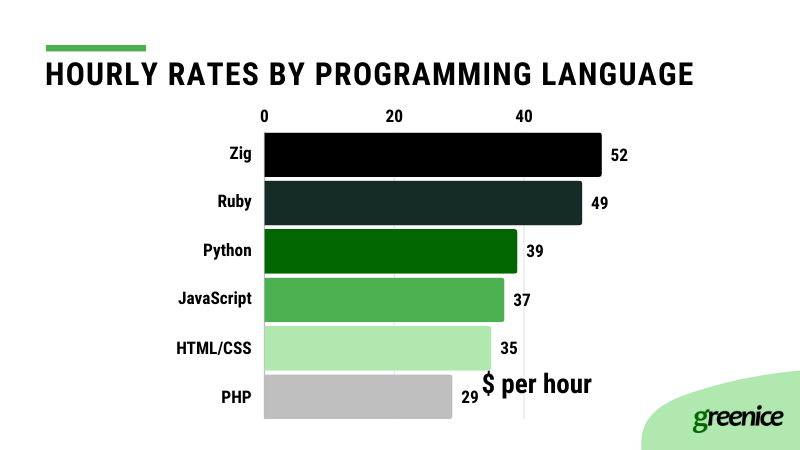
- Location: Developers in North America and Western Europe generally have higher rates than those in Eastern Europe or Asia. This happens due to several reasons like average salaries in those countries and overall living expenses. But as a rule, you can find decent developers in any location. That’s why many business owners prefer hiring offshore specialists to save money. So how much does it cost to outsource software development? Compare these prices given in Accelerance report:
- Hourly rates of North America developers - $62-209 per hour
- Hourly rates of Eastern Europe developers - $26-40 per hour
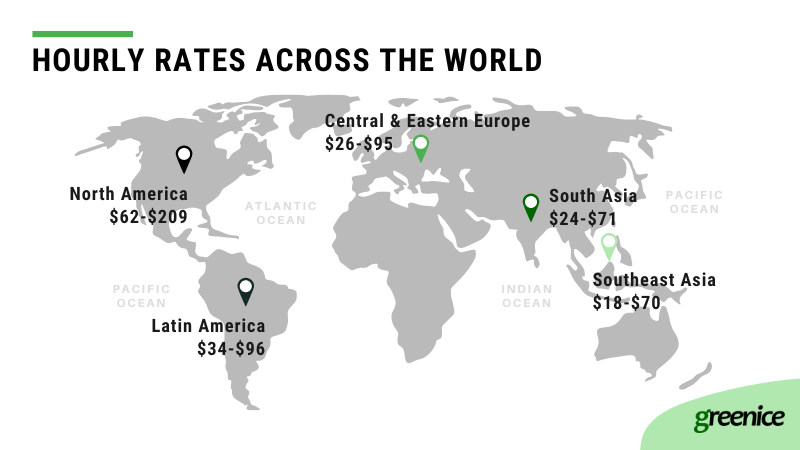
Why Eastern Europe is the top destination for software development outsourcing
Eastern Europe is increasingly recognized as a prime location for IT and software development outsourcing, particularly for US companies looking to enhance their capabilities while managing costs effectively. The region offers a compelling mix of highly educated and skilled developers, competitive pricing, and cultural compatibility, making it an attractive alternative to other outsourcing destinations. Key advantages include:
- Highly skilled talent pool: Eastern European countries are known for their strong emphasis on STEM education, producing a significant number of IT graduates equipped with cutting-edge skills each year.
- Cost efficiency: Countries in this region offer lower labor costs compared to Western Europe and North America, providing substantial cost savings without compromising quality.
- Cultural and geographical proximity: The close cultural ties and geographical proximity to Western Europe make Eastern Europe particularly appealing for US companies, facilitating smoother collaboration and communication.
- Robust English proficiency: Developers in Eastern Europe generally possess strong English language skills, ensuring effective communication with international teams.
- Strong IT infrastructure: The region boasts a rapidly growing IT sector, supported by modern infrastructure and a proactive approach to adopting new technologies.
This blend of talent, cost-effectiveness, and strategic location positions Eastern Europe as a top choice for outsourcing software development, offering US companies a balance of quality and value that is hard to match.
Hire a skillful development team for $30/hour
Contact UsPricing model
No surprise that the way the project is priced will affect the overall costs. Here are a couple of options:
- Fixed price: This model employs waterfall planning, which contrasts with the agile approach by requiring that every detail be specified at the outset, as changes during the development process are not permitted. It offers a predetermined cost for the project, typically including a premium for risk. However, accurately estimating the full scope and potential complications upfront can be challenging. Consequently, the fixed-price model is generally suited only for small, predictable projects that can be completed within 1-2 weeks, or in strictly regulated sectors like healthcare. Nonetheless, even these projects often benefit more from an agile approach than from a traditional waterfall methodology.
- Time and material: In contrast to the fixed price model, the time and material (T&M) pricing strategy offers flexibility and is closely aligned with agile development methodologies. This model charges clients based on the actual time spent by developers and the materials (or resources) used during the project. It's particularly advantageous for projects where the scope is not clearly defined from the start or is expected to evolve. The T&M model encourages continuous collaboration between clients and developers, allowing for adjustments throughout the development process, which can lead to more innovative and tailored solutions.
Other cost factors
There are additional expenses associated with software development. For example, services that need to be integrated with the project.
- Third-party services: Software development often requires integration with third-party services, which can include APIs for payment gateways, data enrichment, social media functions, and more. Each of these services might have its own licensing fees, which need to be considered in the overall budget.
- Cloud services: Cloud services play a crucial role in modern software development, especially for applications that require scalability, reliability, and global accessibility. Cloud platforms like AWS, Azure, and Google Cloud typically charge based on the amount of computing resources consumed, storage used, and data transferred. These costs can vary widely based on the application's architecture and usage patterns. Effective management and optimization of cloud services are crucial to control expenses without compromising on performance.
How to cut costs in software development
While development is an expensive process and too low prices often mean poor quality, it’s still possible to cut some expenses and remain cost-efficient. Here are some ideas:
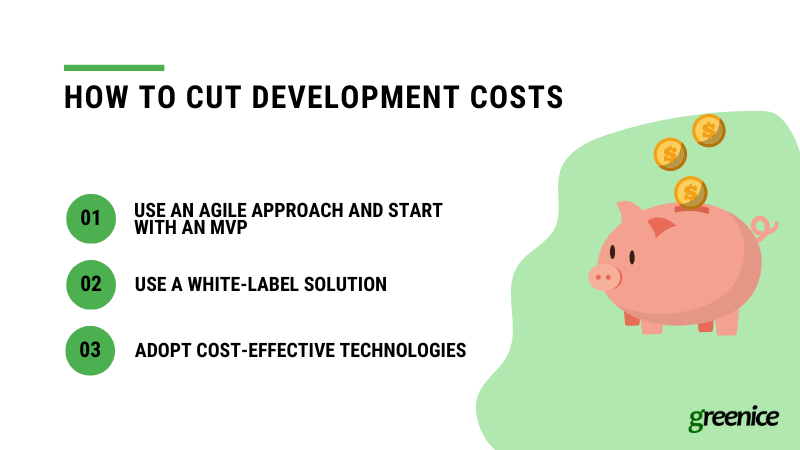
- Use an agile approach and start with an MVP: Implementing an agile development process and beginning with a Minimum Viable Product (MVP) can significantly reduce costs. This approach allows teams to develop software in iterative cycles or sprints, which provides frequent feedback opportunities and the ability to make adjustments early in the development process. Starting with an MVP means focusing on core functionalities that address the primary needs of users, minimizing initial investment and allowing for informed decisions on further development based on user feedback and product viability. For example, creating an MVP for CRM allows the launch of this product for $15,000 instead of $30,000 for a full version.
- Use a White-label solution: Opting for white-label solutions—software you can build upon instead of starting from scratch —can also lead to substantial cost savings. This method eliminates the need for extensive research and development since the part of the code is already developed and tested. Businesses can customize the white-label solutions and extend them with new features to meet their specific needs, which significantly cuts down on both development time and costs. For example, a starting point for marketplace development is $15,000, while white-label solutions allow reducing the cost to $5,000.
- Adopt cost-effective technologies:
- Open-source: Leveraging open-source software can dramatically reduce project costs. Open-source tools and platforms do not require licensing fees, and they provide the flexibility to modify and tailor the software to specific requirements. Moreover, they are supported by large communities of developers who continuously contribute to improvements and offer support.
- Cross-platform development: Using cross-platform tools such as React Native or Flutter for mobile app development allows developers to write code once and deploy it across multiple platforms (iOS and Android). This approach reduces the need for platform-specific teams, which not only cuts down on development time but also staffing costs.
Conclusion
Software development can be complex and expensive, with costs mainly driven by how much developers charge per hour and how long they work on the project. In this article, we've explained these key factors and offered some tips on how to keep costs down. By understanding these points, you can make better decisions that help save money while still getting the job done well.
At Greenice, we leverage a combination of industry expertise, efficient project management, and advanced technological practices to ensure that your investment in software development is both cost-effective and value-driven. Whether you're building a new product or optimizing an existing one, our team is here to guide you through every step of the journey, ensuring that you achieve your business objectives without exceeding your budget.
Need help with your project?
Contact UsRate this article!
5







 Sign in with Google
Sign in with Google
Comments (0)